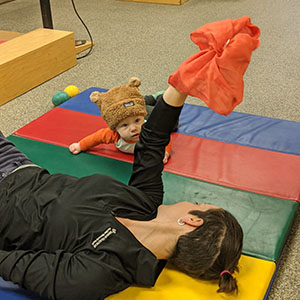Exercising at Home with Your Baby

Part of our Raising Resilient Kids series
As a new parent, it can be very difficult to find time to exercise, especially in the same way you might have pre-baby. To boot, the pandemic has complicated exercise for anyone, let alone a new parent. But that doesn’t mean you have to skip it altogether.
Research shows that any postpartum exercise* can help relieve stress, improve sleep, and reduce symptoms of postpartum depression. Even in the initial postpartum months, light movement – slow walks or gentle yoga – can make a significant difference as you build back to your regular exercise regimen.
As you feel stronger, try incorporating some new exercises. We asked Paul Oliver Memorial Hospital physical therapist Adrienne Jones (mom of two) and the Mary Free Bed at Munson Medical Center physical therapy team to share their favorite 60-second exercises that can be done with your baby. Squeeze them in individually, throughout the day, or do them all at once – whatever you and your baby are up for.

Before you get started, be sure to check out these tips for parent and baby:
- Make sure your baby can hold his/her head up without discomfort (usually around 3-4 months).
- Engage your baby! Make eye contact, sing songs, count aloud, and smile at your baby.
- Aim to do three sets of 8-10 repetitions of each exercise, but don’t worry if you aren’t able to complete them all.
- Set realistic expectations. Your baby might not cooperate every time. Sneak in movement when you can and enjoy the time with your little one.
- Find a buddy! Exercising with a friend or group may feel more doable (and be more fun). Connect with friends or other moms on social media for support.
“When exercising with your baby, your goal is to keep them engaged and happy so you can finish your workout! You can do this by incorporating visually stimulating scarves or toys to hold your baby’s attention,” shares Stephen Jones. “A newborn-to-2-month-old can only see 8-10 inches from his/her face, so make sure objects are close. They prefer bright colors, or contrasting patterns. As babies reach 3-4 months, they will be able to see several feet in front of them. As they grow older, they’ll get a kick out of coming along for the ride. Hold them as you squat or lunge, or lie on your back and press them to the ceiling. Talk to you baby throughout, it will be a great experience for both of you!”
*Be sure to discuss the appropriate timing and type of exercise with your provider before starting.
Exercises with Baby
Plank
Get into a modified push-up position. With your baby laying face to face with you, raise your knees from the ground, and keep your body straight. Please note: New moms with diastasis recti should talk with their healthcare provider about alternative core exercises.

Arm & Leg Raise
With all fours on the ground, raise one arm (with a colorful scarf in-hand) and the opposite leg. Lower, switch and repeat.
Lunge
With your child close to your chest, step forward with one leg, lowering your hips to the ground. Place your child on your knee.
Squat
With your feet shoulder width apart, bend your knees and lower your hips. Hold your child directly in front of your chest. Start with mini squats, stopping about a third of the way down, and progressing to a deeper squat as you become more comfortable.
Dead bugs
Holding a colorful scarf in one hand, bend your hips and knees at a 90-degree angle. Lower your right arm and left leg to the floor and lift back up.
Push-ups
Lay flat on your back and hold your baby firmly around their core. Slowly lower to your chest and push back up.
Remember: Getting back to exercise postpartum is hard – anything you try will be enough.
More Support for New Moms
Virtual Yoga
Our virtual prenatal yoga classes are a great way to connect with other Moms and Moms-to-be.
Virtual Breastfeeding Support
Talking with others about the things you’re experiencing helps build support. Join our free virtual breastfeeding support group.
Enjoying These Tips? Get More Ideas by Checking Out the Other Blogs in Our Raising Resilient Kids Series:
- Video Chats: Keeping Kids Engaged
- Cooking With Your Kids
- Healthy Lunch and Snack Ideas for Kids
- Mindfulness for Children
- Winter Activities for Kids